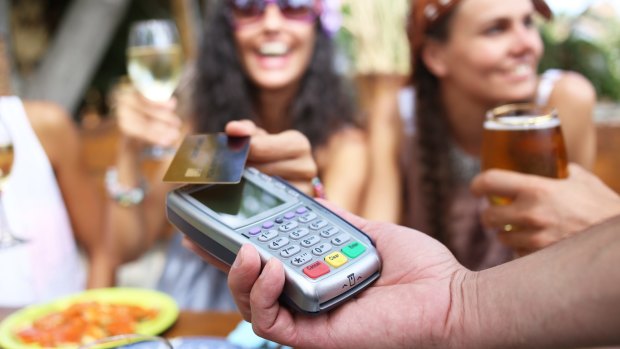This was published 2 years ago
Dynamic currency conversions: Don't pay in your own currency when you're overseas

It is increasingly common for tourists to be invited to "pay in your own currency" via electronic transfer when overseas.Credit: iStock
Do not pay in your own currency. That's it. That's the takeaway here. If there's nothing else you remember from reading this small column, make it this: do not pay, when you're travelling overseas, in your own currency. In Australian dollars.
What we're actually talking about here is something called dynamic currency conversion. It sounds sexy, and the chance to "pay in your own currency" when you're overseas and a little confused about exchange rates also sounds quite attractive. It seems inherently trustworthy. Something that makes sense.

Give dynamic currency conversion the boot. Illustration: Greg Straight
You're likely to see this option next time you're in a foreign country and you're using a credit or debit card at point of sale. This might be while paying at a restaurant, settling the bill at your hotel, buying something at a boutique, or myriad other situations in which an eftpos machine would be waved in front of you.
You will swipe or tap your card, and then an option will come up: pay in local currency – say, euros – or pay in your own currency. The machine will give you the cost in euros, and in Australian dollars. You simply select which you would prefer.
And of course, Australian dollars seem safer. It's only later, when you look up the current exchange rate and do the calculation yourself, that you realise what's going on.
The exchange rates offered when doing a dynamic currency conversion are uniformly awful. Far worse than the official rate (even banks probably won't give you that exact rate, but it will be better).
These dynamic conversions also factor in several fees, including a cut for the vendor who's waving the eftpos machine in your direction, and for the company that is facilitating the transaction.
In other words, it's a rip-off.
It's also very easy to find yourself hitting "pay in your own currency" if you're not familiar with the system. Now, however, you are.
But there's more. In recent years, these dynamic transactions have made their way from the eftpos machine to the ATM, bringing their high fees and charges with them. Most travellers by now are familiar with the idea of ATMs charging for transactions, but this is something else entirely.
Again, it begins simply enough. You put your card in the machine, you select the amount of local currency you want to withdraw, and you wait. But then the ATM will prompt you with a question, showing you the amount you're about to withdraw in Australian dollars (which is unusual), and asking if you're happy to accept that conversion.
This is the trick. It's a horrible conversion. The rate is bad, and it includes commissions and fees.
You may think this is the only option, and grudgingly hit "confirm", but you don't have to. If you hit "cancel", you will still get your money, only at a much more reasonable rate decided by your bank, and without the fat commission on top.
Get yourself the right debit or credit card – say, with ING, or 28Degrees – and you won't even have to pay a fee to use a foreign ATM. And that's another healthy saving.
See also: Why are flights to Europe so expensive? Blame China
See also: Why you should never use a travel money card
Listen: How to manage your money overseas
Sign up for the Traveller newsletter
The latest travel news, tips and inspiration delivered to your inbox. Sign up now.







